Samosa is a crispy, golden-fried North Indian snack with a flaky pastry shell filled with a savory, spiced, tangy mixture of mashed potatoes, green peas, and aromatic spices. This iconic street food is often served hot with sweet tamarind and spicy green chutneys, making it a beloved tea-time treat across Delhi, Punjab, and beyond.
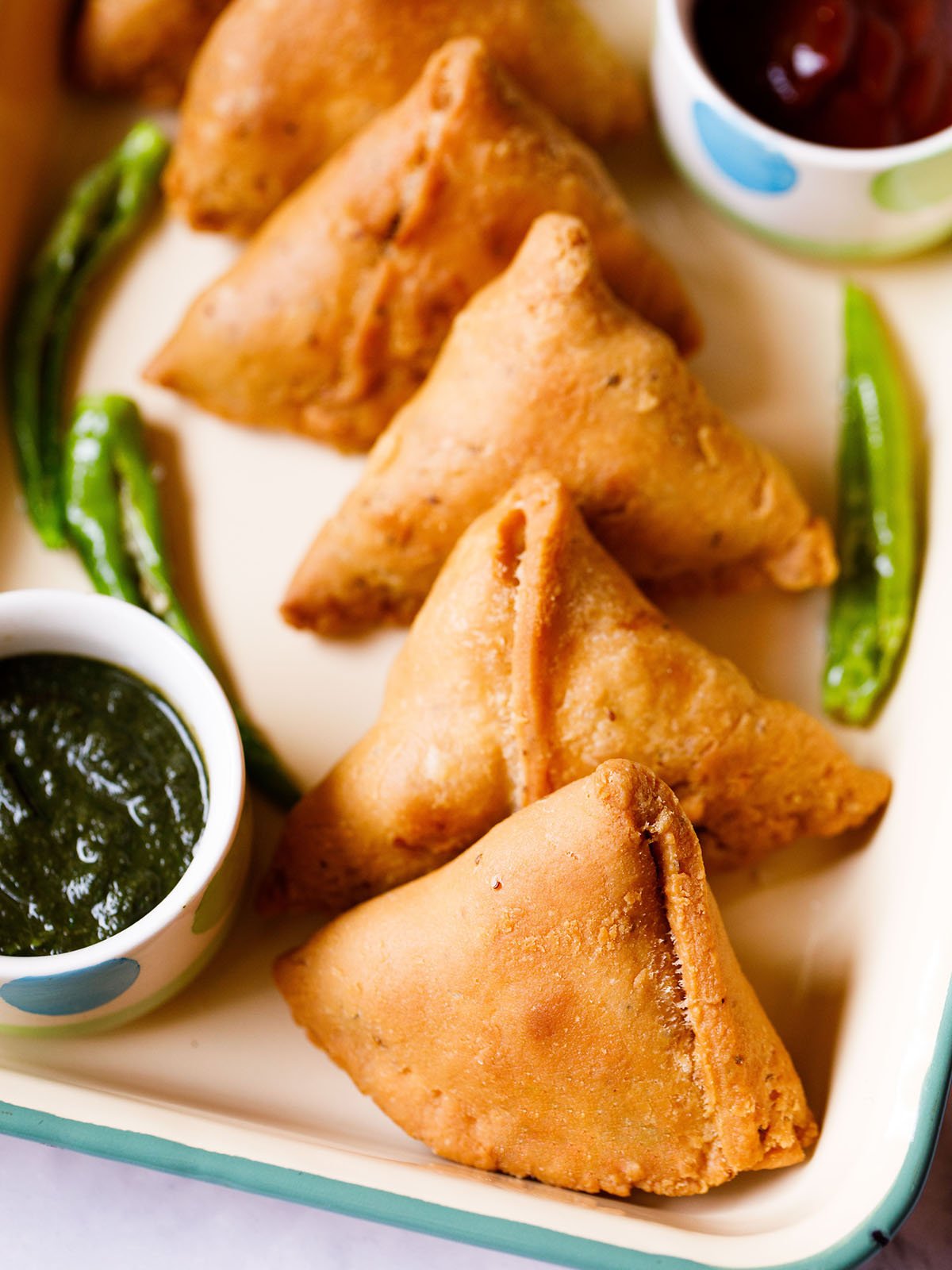
Punjabi Samosa – A Crispy, Spiced Classic
A samosa is a deep-fried Indian snack with a crisp, flaky crust and a savory filling –usually spiced potatoes and peas. Flaky and crunchy, samosas are among the most beloved street food snacks in North Indian cuisine.
They have a pastry-like shell and a comforting, spiced potato and green peas stuffing that makes them incredibly satisfying.
What makes this the best homemade samosa recipe? As a trained pastry chef who’s worked with everything from laminated doughs to shortcrusts, I can tell you –achieving that golden, flaky crust comes down to the right balance of fat and water.
Table of Contents
In this recipe, I use slightly less water than usual to create a firmer, flakier dough. This is the same trick I use when making samosa pie – a baked, non-fried version that’s just as delicious.
The filling is hearty, gently spiced, and easy to prepare in a pressure cooker, Instant Pot, or stovetop pan. It’s based on a version from my old cooking school notes and has become a favorite at home.
You’ll find a video included that shows exactly how I shape, fill, and fry the samosas; perfect if you’re making them for the first time and need a visual reference.
Crispy on the outside, soft and spiced within—this step-by-step guide will help you master the art of making authentic Punjabi samosas from scratch.
Step-by-Step Punjabi Samosa Recipe
Below is my complete step-by-step guide with photos for making the best Punjabi Samosa recipe from scratch.
You start by making the savory filling and pastry dough. Then assemble the Aloo Samosa, fry, and enjoy with your favorite dipping sauces and chutneys!
Boil Potatoes & Cook Peas
1. The first step is to cook the potatoes and peas for the savory and spiced filling.
- To cook the potatoes and peas in a stovetop pressure cooker: Place 3 medium-sized whole potatoes (300 to 450 grams) and 2 to 2.5 cups water in a 3 or 4 litre pressure cooker. On top of the potatoes carefully set a small trivet and pressure cooker-safe bowl with ½ cup green peas. Pressure cook for 5 to 6 whistles or 7 to 8 minutes on medium to medium-high flame.
- If using an Instant Pot: Place 3 medium-sized whole potatoes in the steel insert of a 6 quart IP. Add 2 cups water. Place a trivet on top of the potatoes, and on top of the trivet set a bowl with ½ cup of green peas. Pressure cook on high for 20 to 25 minutes.
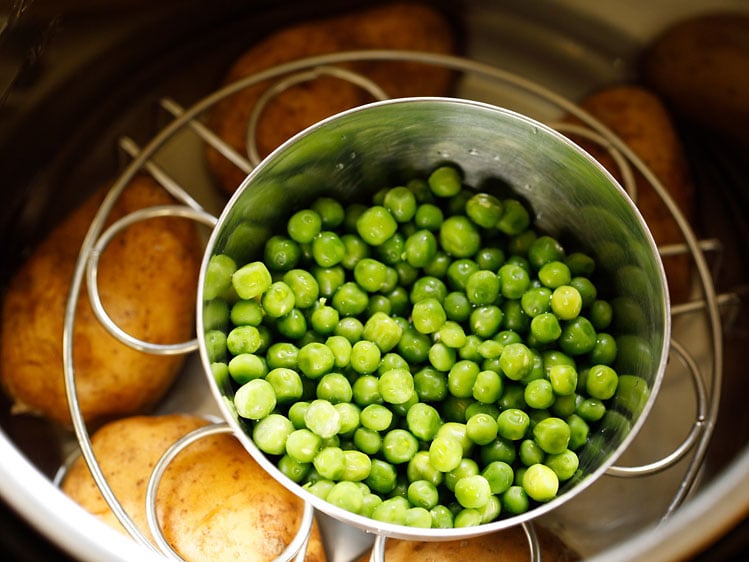
2. For the stovetop pressure cooker, remove the lid after all the pressure falls in the cooker.
For the Instant Pot, do a quick pressure release after 5 to 7 minutes. Check with a knife or fork to see if the potatoes are cooked well.
The knife or fork should be able to slide through easily if the potatoes are cooked properly.
If the potatoes are undercooked, then cook them for a few more minutes using the pressure cook function. Once done, drain the potatoes and peas in a colander and set aside to cool.
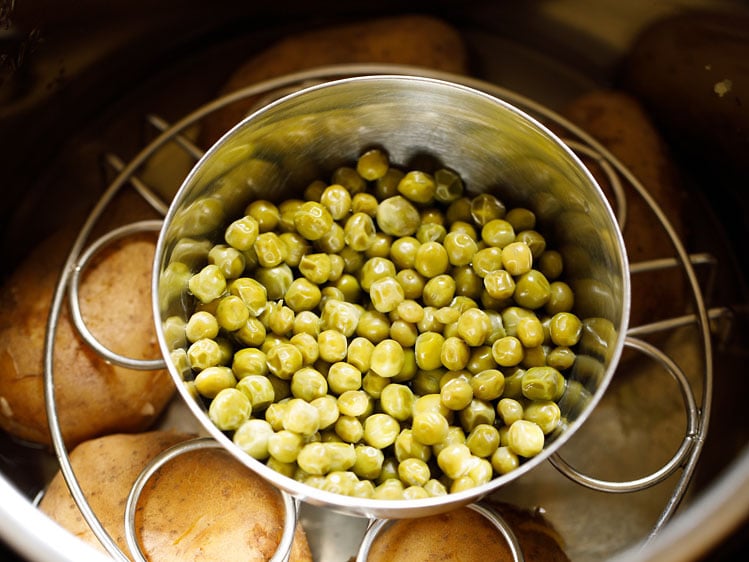
Lightly Toast & Crush The Whole Spices
3. Next, roast or toast the spices. This will help to release their flavors and should not be skipped!
To a small frying pan over low heat add the following spices:
- ½ inch cinnamon stick
- 1 clove, optional
- 1 green cardamom
- 3 black peppercorns
- ½ teaspoon cumin seeds
- ½ teaspoon fennel seeds
- 2 teaspoons coriander seeds
Heat the spices for just a few minutes until aromatic, being careful to not burn.
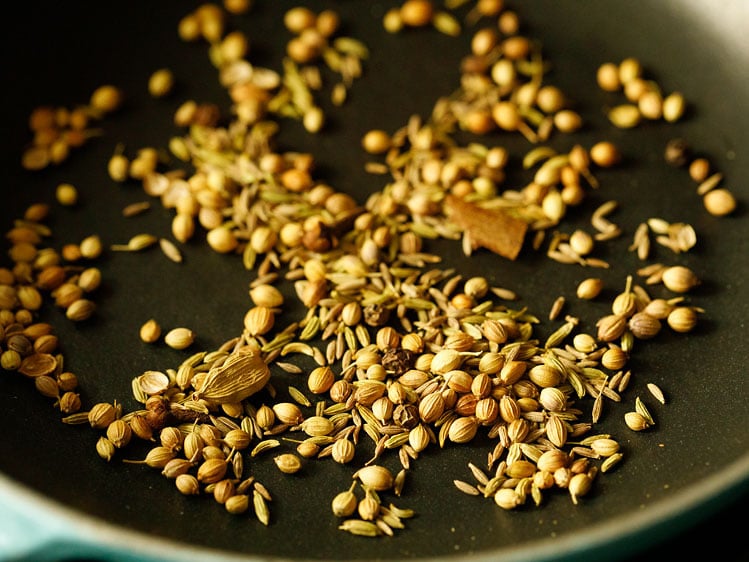
4. Remove the spices from the heat and allow to cool completely. Then, put them in a spice grinder or small mixer-grinder jar.
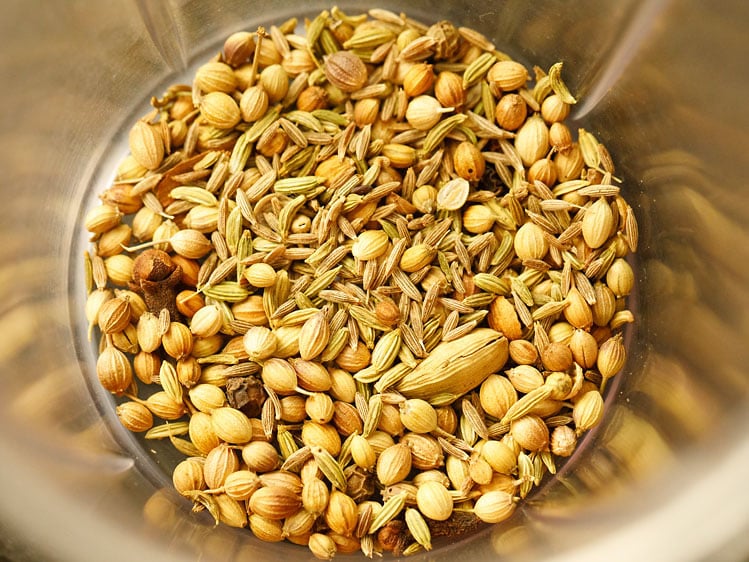
5. Grind the toasted spices to a semi-fine powder, and set aside.
In a Hurry? Use This Quick Spice Blend Instead
Mix together:
- 2 teaspoons coriander powder
- ½ teaspoon cumin powder
- ½ teaspoon fennel powder
- ½ teaspoon garam masala
Add this spice blend in step 9, along with the green peas and other ground spices.
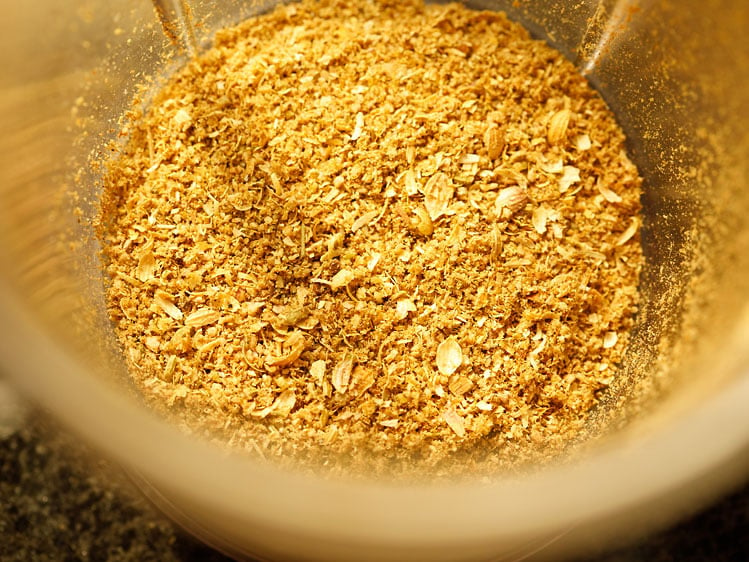
Make The Tangy-Spiced Potato Stuffing
6. Peel the skin off of the cooked potatoes, and chop them in ½ to 1 inch cubes.
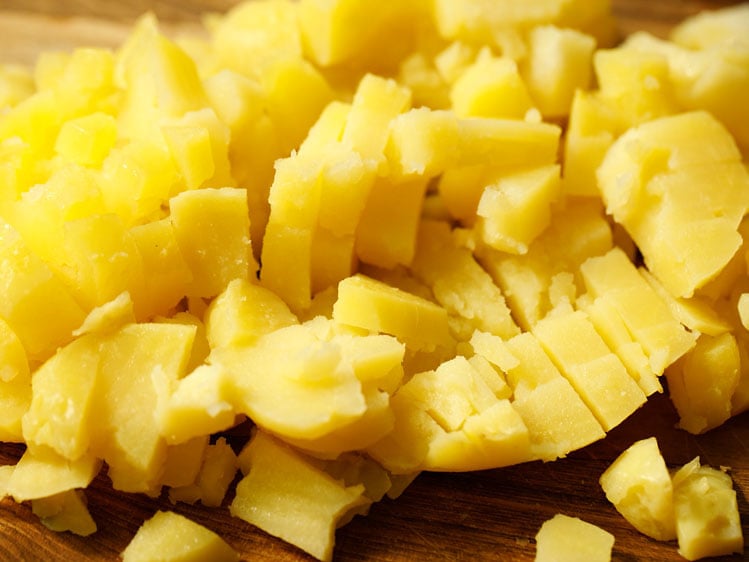
7. In a small skillet, heat 1 tablespoon oil. When the oil becomes medium hot then reduce the heat to low.
Crackle ½ teaspoon cumin seeds until fragrant. I used mustard oil as it really adds a punch in the stuffing.
You can use neutral oil like sunflower oil, safflower oil, grapeseed oil or canola oil.
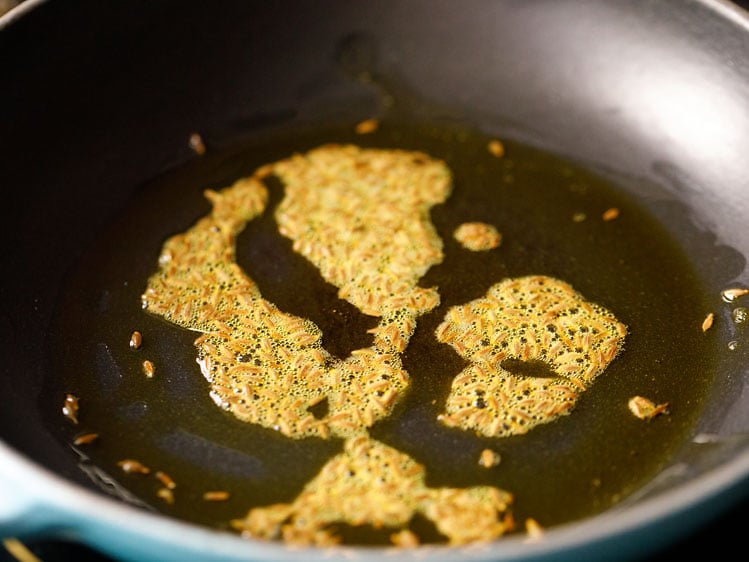
8. Keep the heat on low and add 1 teaspoon finely chopped or minced ginger and 2 teaspoons finely chopped green chillies.
Sauté for a few seconds until the raw aroma of ginger goes away.
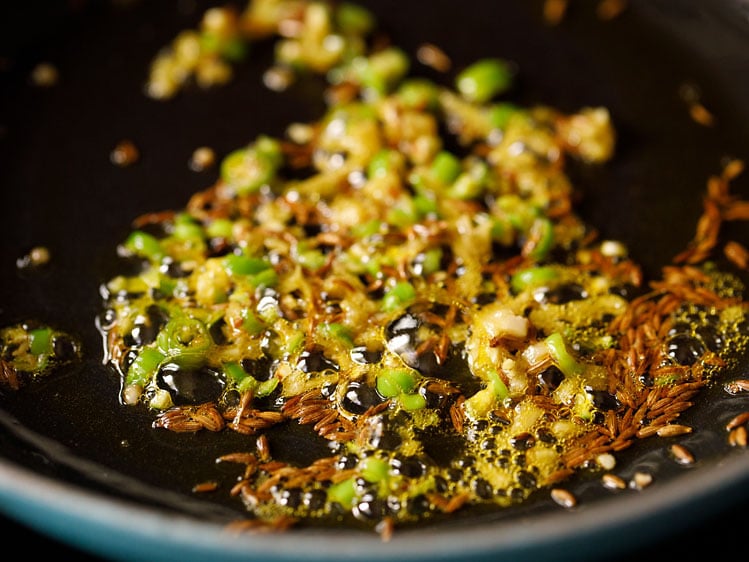
9. Now either switch off the heat or reduce it to low, then add:
- Cooked green peas
- ½ teaspoon red chilli powder
- 1 pinch of asafoetida (hing)
- The prepared dry spice mix
- 1 to 2 teaspoons dry mango powder (amchur)
The mango powder is what gives the Punjabi Samosa filling its signature tangy flavor that balances so well with the savory, spicy flavors of the other stuffing ingredients.
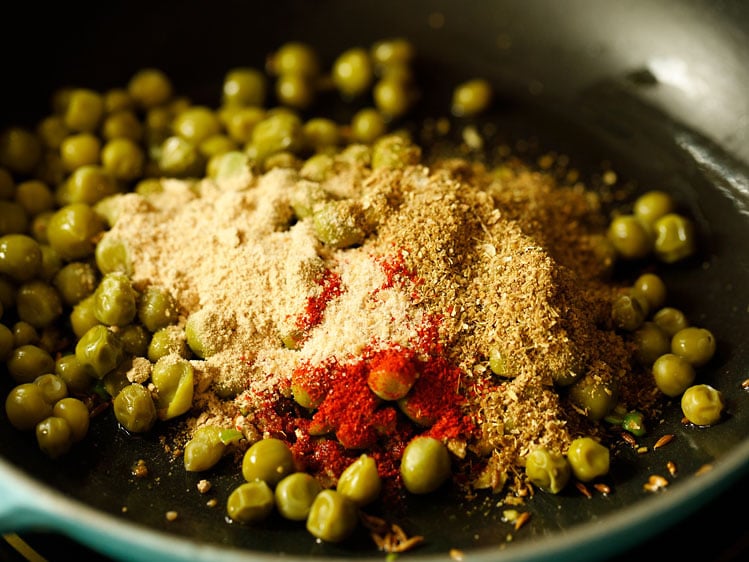
10. Stir together and sauté for a minute. You can add less or more dry mango powder depending upon personal taste.
I added 2 teaspoons as just 1 teaspoon was not quite enough sour flavor for me.
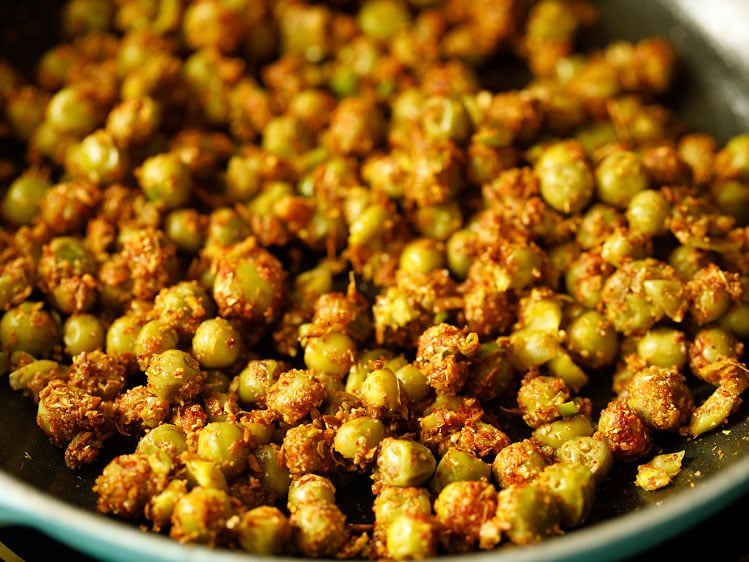
11. Next add potato cubes, salt as required and 1 to 2 tablespoons chopped coriander leaves (cilantro) to the skillet.
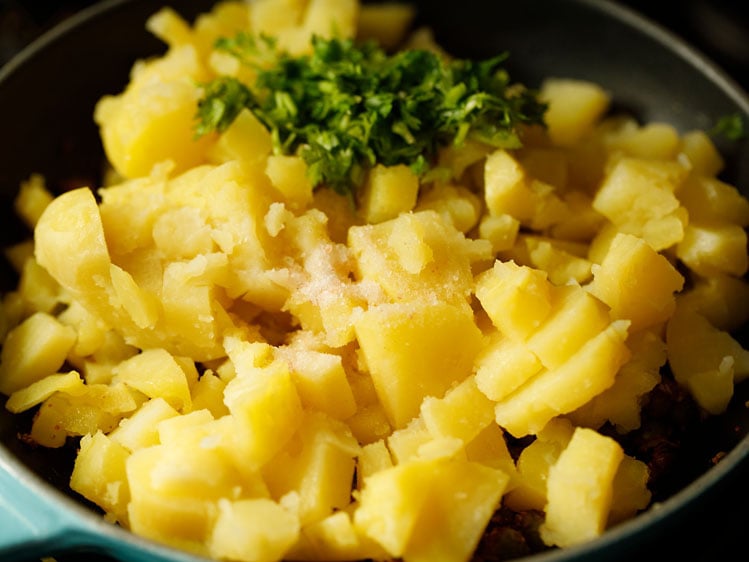
12. Mix very well and sauté for a minute. Check the taste, and add more of the spices, salt or dry mango powder if needed.
Cover and set the filling aside while you make the dough.
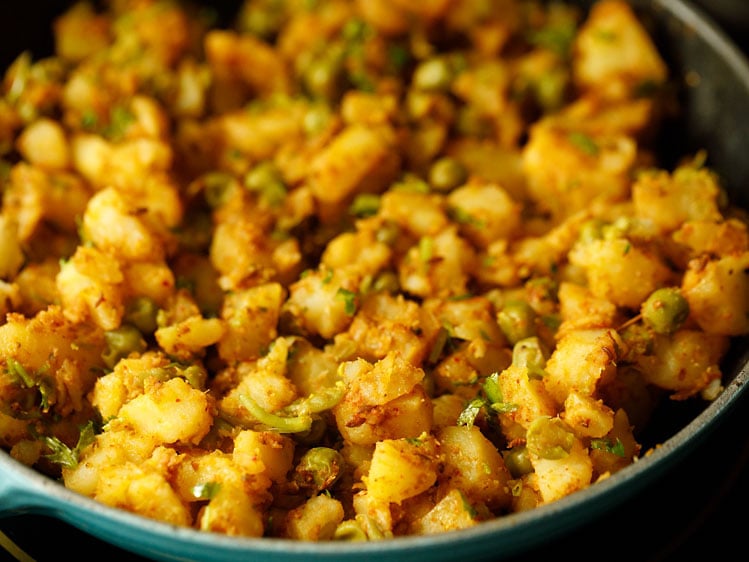
Make Samosa Pastry Dough
13. In a large mixing bowl combine 2 cups all-purpose flour (250 grams), 1 teaspoon carom seeds, 1 teaspoon salt and 6 tablespoons ghee (50 grams).
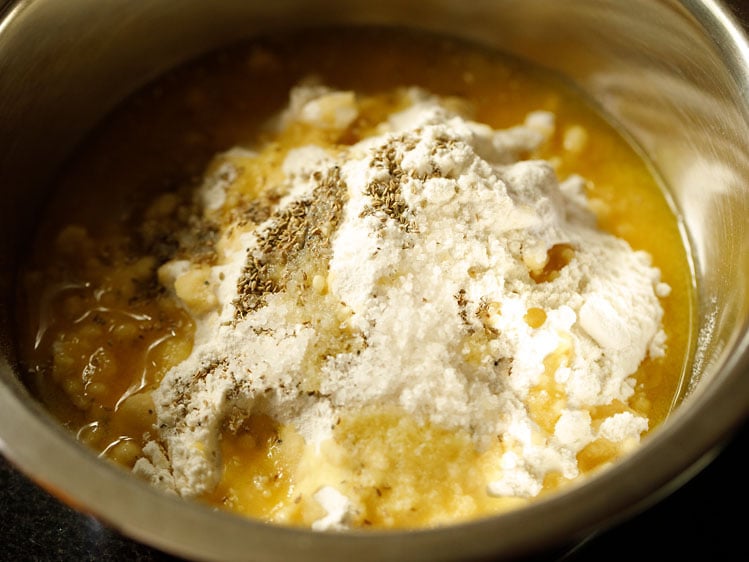
14. With your fingers, mix the ingredients together until they make a breadcrumb-like texture that holds its shape when you press a portion of the mixture.
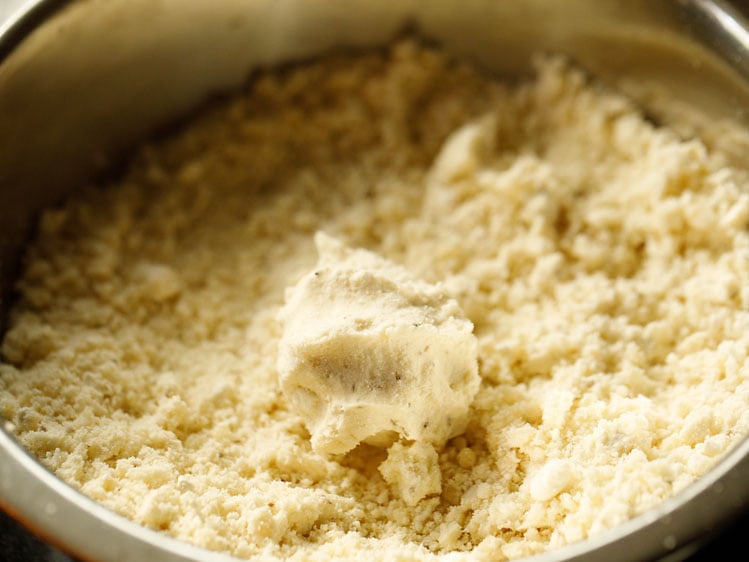
15. Then, working just a bit at a time, add in 7 to 8 tablespoons water in parts and knead.
You can add 1 to 2 tablespoons extra water if needed if the dough looks floury or dry.
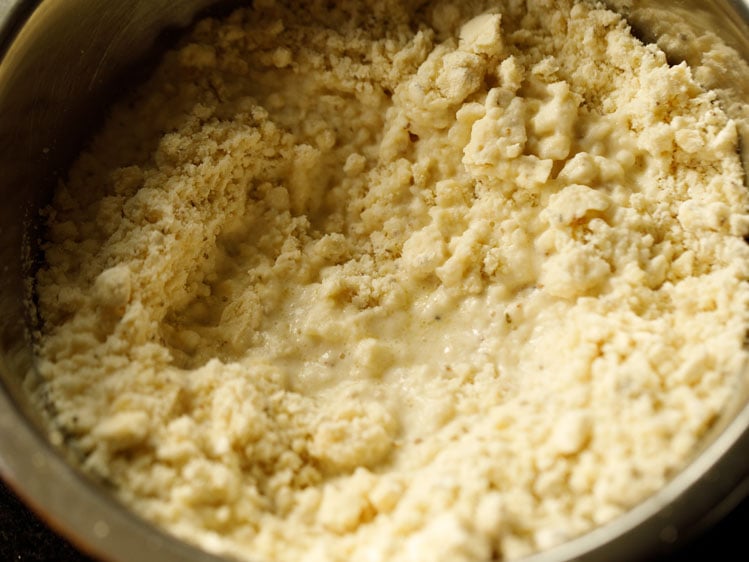
16. Continue kneading to form a firm, tight dough. It should not be soft or sticky. Cover the dough with a moist kitchen towel and let rest for 30 minutes.
In case if your dough becomes too moist or sticky then add a few tablespoons of flour. Mix and knead again to a firm dough.
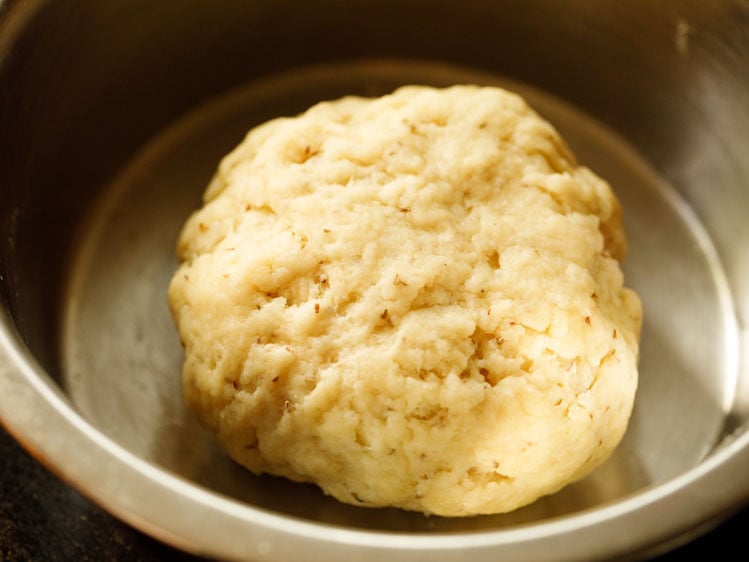
Shape, Fill & Fold
17. After the dough has rested, divide it into 6 to 7 even pieces. Take each piece and gently roll in your palms first to smooth and soften. Place it on your work surface or on the rolling board.
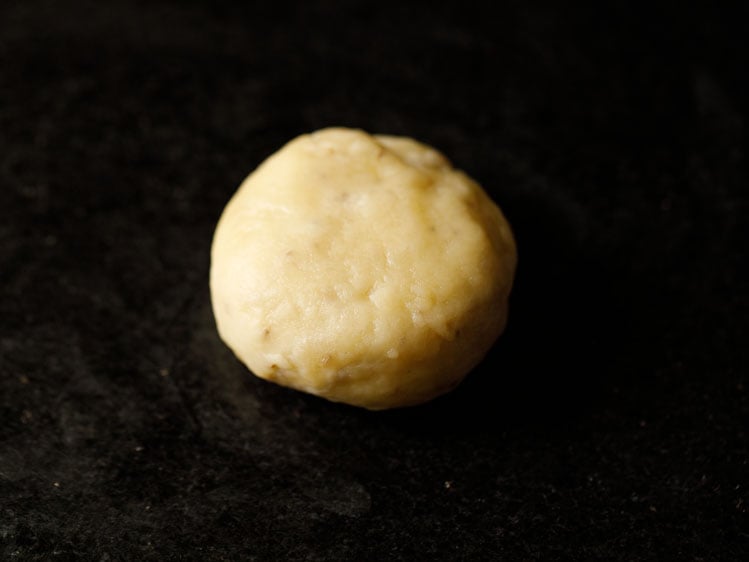
18. Then roll it with a rolling pin, being mindful to keep the thickness even at 1 mm and not too thin.
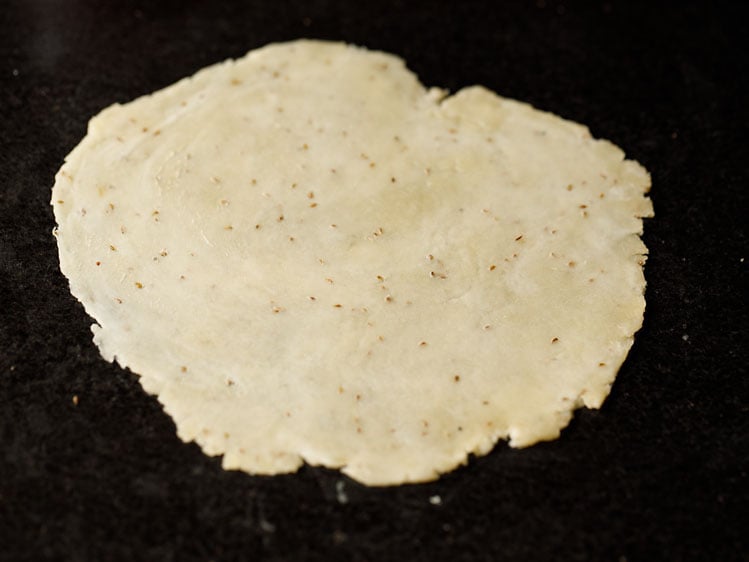
19. Cut the with a knife or a pastry cutter, right through the center of the rolled pastry dough.
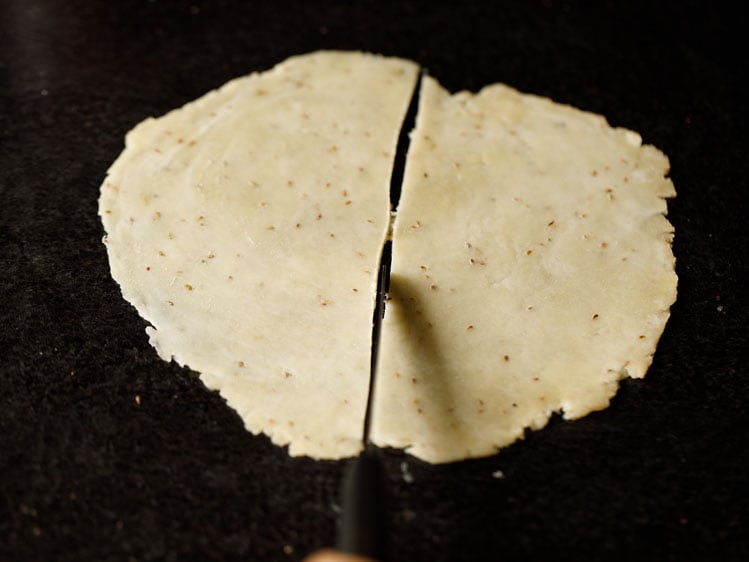
20. Use a rolling pin to gently flatten the half moon shape to make even.
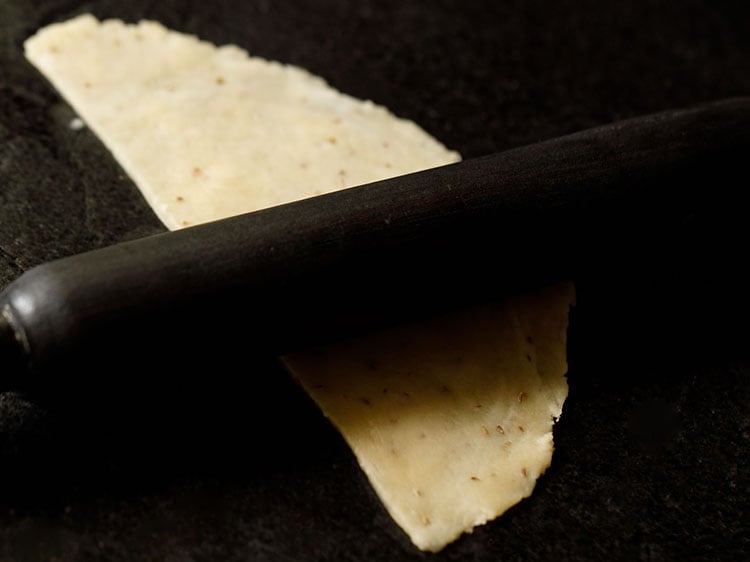
21. Use a pastry brush to lightly brush the dough with water around all of the edges.
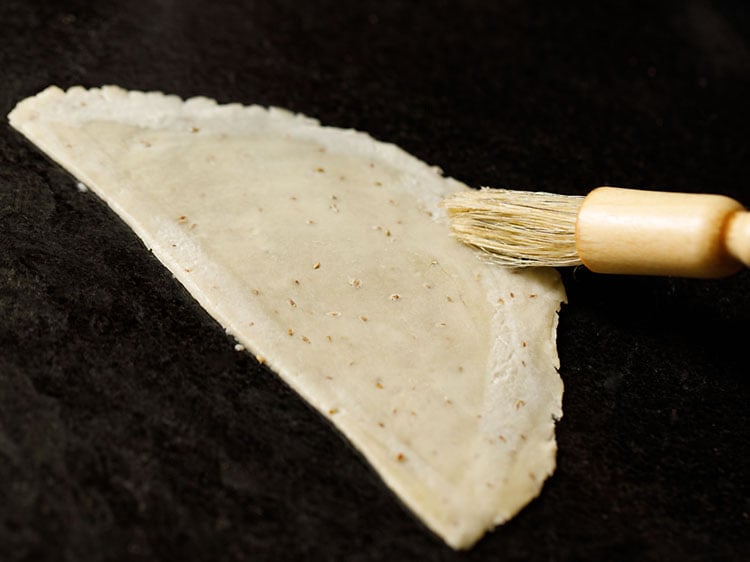
22. Next, fold to join the straight edged side together to form a cone, like shown in the photo below. Be sure to press the edges well so that they are sealed!
The cone is now ready to be stuffed with the potato and pea filling.
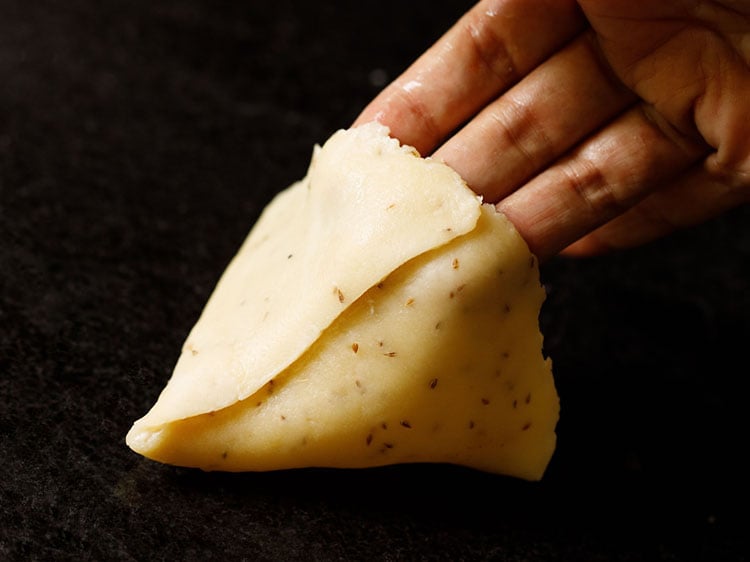
23. Carefully spoon and lightly pack the prepared potato and pea stuffing into the cone.
Make sure to not over or under-fill to prevent the samosa from bursting during the frying process.
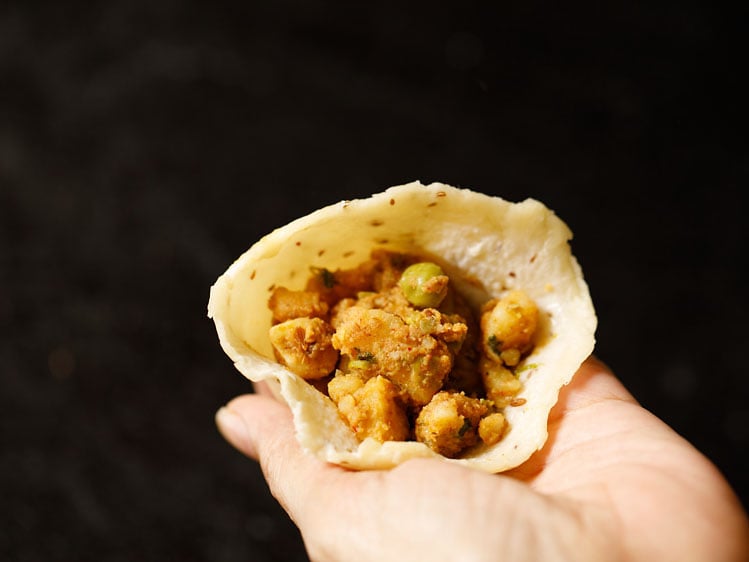
24. Crimp and pinch the edges to close as shown in photo below. This helps the samosa to stand once made.
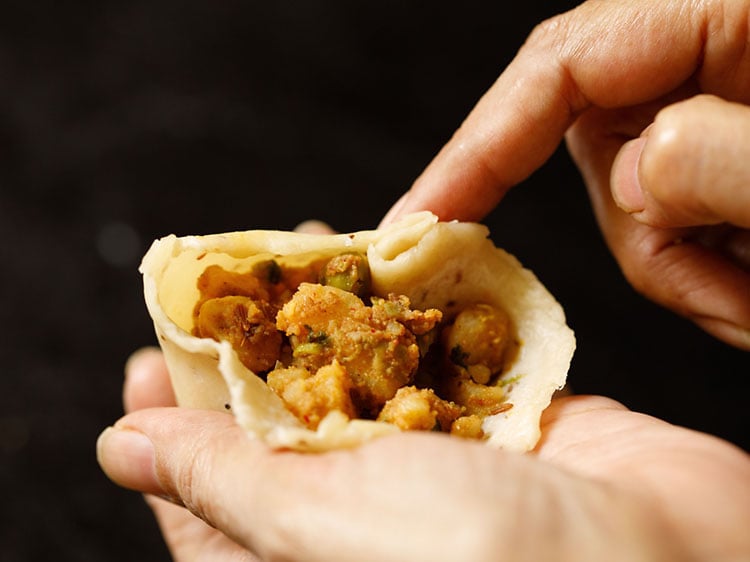
25. Evenly press all of the edges, making sure there are no cracks in the dough. The edges should be sealed very well so that the stuffing does not come out while frying.
Prepare all the samosa this way as described above, and cover with a moist kitchen napkin to keep them from drying out.
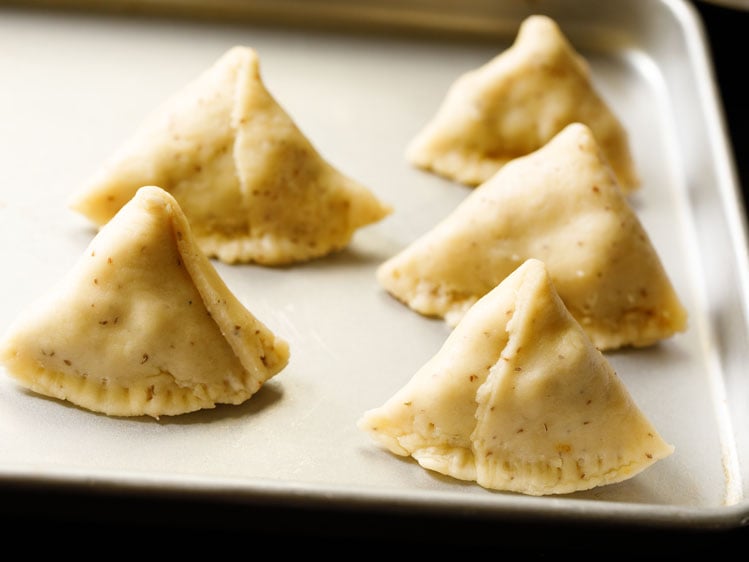
Deep Fry Samosa
The final step to making the best samosa is to fry them to a perfectly crisp golden brown.
Use any neutral flavored oil to deep fry – sunflower oil, canola oil, vegetable oil, safflower oil, grapeseed oil are some options.
26. Heat the oil for deep frying in a kadai or pan. Test the oil by adding a small piece of dough – it should come up quickly if the oil is hot enough for frying.
Once the oil becomes medium-hot, gently slide 3 to 4 of the prepared stuffed samosas into the oil, and then immediately reduce the heat to low.
Do not overcrowd the pan to ensure each one of them fries evenly!
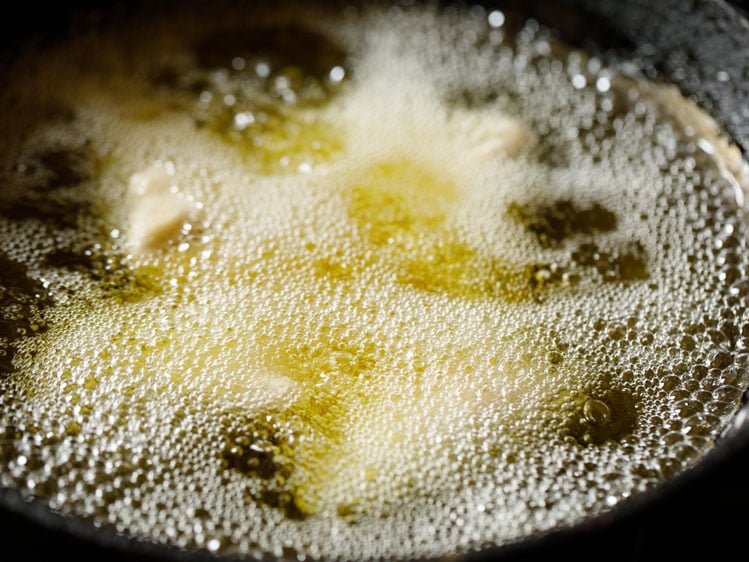
27. Fry them on low to medium-low heat, keeping an eye on them so they don’t burn.
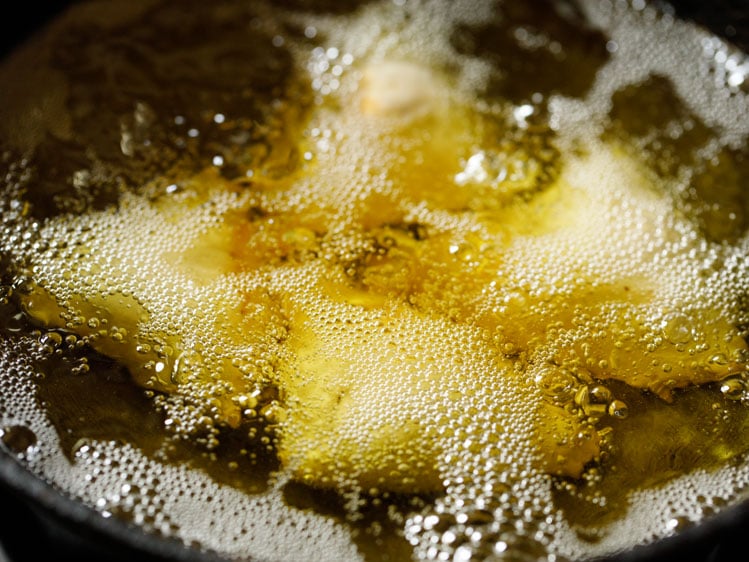
28. When one side is pale golden, use tongs or a slotted spoon or skimmer to gently turn each samosa over and continue frying.
This way you will have to turn a couple of times for even cooking. Be gentle and careful while turning them as they are heavy and oil can spill out.
Frying these take a lot of time, so you have to be calm and patient!
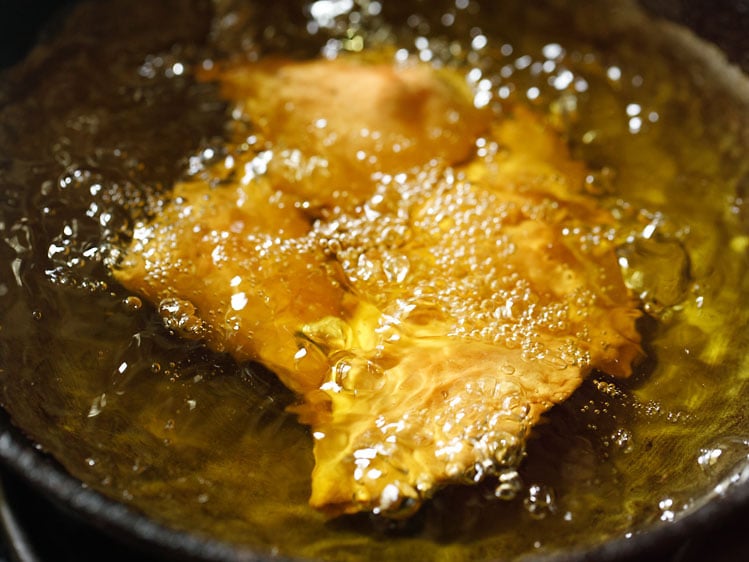
29. Fry until each aloo samosa is crisp and golden. The oil will stop sizzling once the samosas are fried well. They will become nicely crisp and golden.
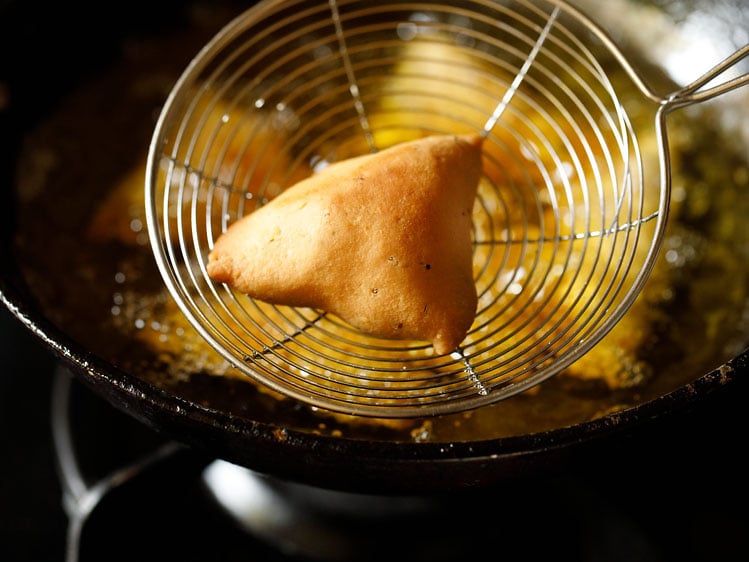
30. Use a skimmer spoon or spider spoon to carefully remove fried samosa from the oil, and place them on paper towels to remove extra oil.
Repeat the frying steps with the remaining batches of Aloo Samosa. Reduce the heat when you begin to fry the next batches. Regulate the heat as needed while frying these.
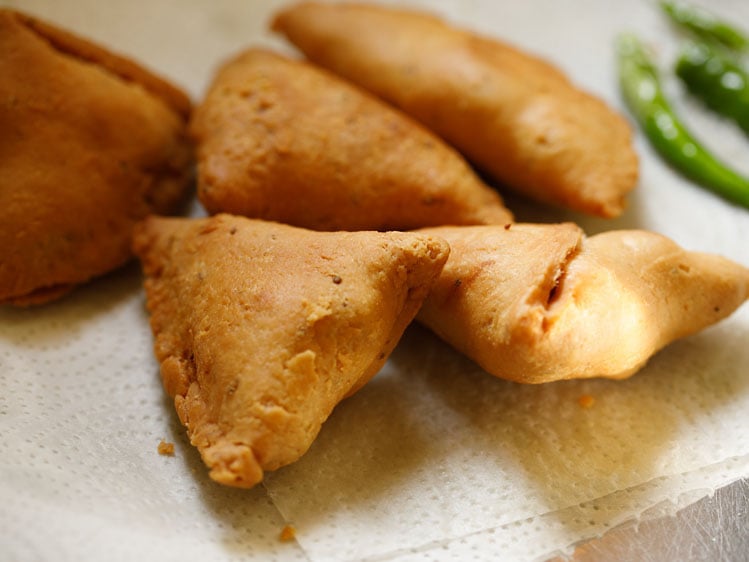
31. Serve Punjabi Samosa hot or warm or at room temperature with Coriander Chutney or Tamarind Chutney, or with a zesty tomato ketchup.
The pairing of Aloo Samosa with masala chai is irresistible and much loved in India.
You can also serve them with Chole Masala. This dish is popularly known as samosa chole. Another popular chaat snack made with potato samosa is Samosa Chaat.
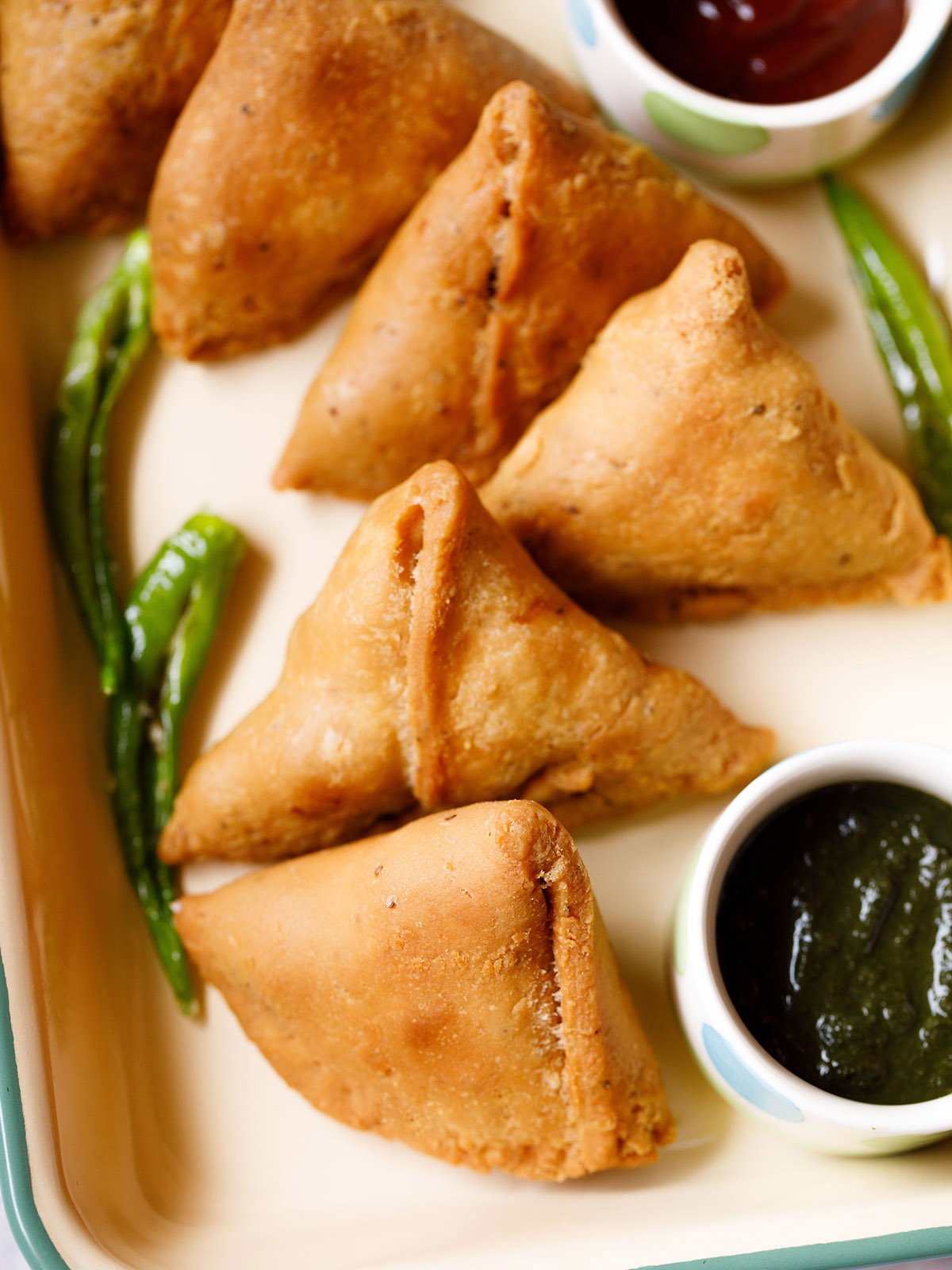
Other Delicious Fillings
Samosa stuffing varies widely across India, depending on the region.
In Delhi and Punjab, a classic filling includes whole (not mashed) potato cubes, sometimes with green peas and chopped green chilies. The flavor is tangy thanks to the addition of dry mango powder or dry pomegranate powder, and a few whole or ground spices.
Some versions include raisins for a sweet-sour taste, and cashews for added crunch. In other places, the stuffing is completely mashed and heavily spiced.
If green chillies are not added to the stuffing, fried green chilies are often served on the side.
Other regional variations include:
- Mixed vegetable samosas with carrots, cauliflower, peas, and potatoes.
- Onion samosa made with a spicy mix of onions and poha (flattened rice).
- Sweet samosa stuffed with khoya, nuts, and dry fruits—popular during Diwali and Holi.
- Paneer samosa with soft paneer cubes in a mildly spiced filling.
- Cocktail samosas, which are mini in size and filled with dry lentils, nuts, and spices.
- Singara, the Bengali version, is smaller, crispier, and often filled with spiced potatoes, cauliflower, and peanuts.
Expert Tips
Wondering how to get that perfectly flaky, crispy samosa crust? Here’s what I’ve learned and tested:
- Proportion of fat: The amount of fat (“moyen” in Hindi) in the dough is crucial. I follow a 1:5 fat-to-flour ratio by weight – so for 250 grams of flour, I use 50 grams of fat. This is the same professional ratio one of my culinary mentors always recommends.
- Proportion of water: The dough should be tight and firm – not soft like roti or bread dough. Add water in parts as needed. Too much water will make the crust soft and prone to oil absorption.
- Rolling the pastry: Roll the dough to an even 1 mm thickness. Too thick means longer frying and harder crust; too thin and the stuffing may burst during frying.
- Seal Properly to Prevent Leaks: When shaping the samosa, moisten the edges with water and press firmly to seal. Any gaps can cause the stuffing to leak into the oil while frying.
- Rest the Dough: After kneading, let the dough rest for at least 30 minutes covered with a damp cloth. This makes the dough easier to roll and helps avoid shrinkage.
- Don’t Overstuff: Avoid adding too much filling, or the samosa may burst while frying. Leave enough space to seal the edges securely and maintain the shape.
- Cool The Stuffing Completely: Always let the potato stuffing cool completely before using. Warm filling can make the dough soft and lead to cracks or splits while frying.
Two Frying Techniques
There are two effective ways to fry samosas for that perfect crust:
1. Low Temperature Frying
First heat oil on medium to medium-high. Add the samosas, then reduce to low or medium-low heat. This prevents oil absorption and helps the crust cook evenly without forming bubbles.
Avoid adding samosas to cold oil (they soak oil), or to very hot oil (they develop bubbles and stay undercooked inside).
2. Double Frying
This method takes more time but gives excellent results. First lightly fry the samosas until the crust turns opaque and creamish-white – do not let them brown. Remove, rest, and then fry again on low heat until golden and crisp.
Both methods yield perfectly cooked samosas—crisp outside, soft inside, just like the halwai-made ones.
Air Fryer Samosa – A Lighter, Crisp Option
Yes, samosas can be air-fried! The texture is surprisingly close to the deep-fried version, minus the extra oil.
Preheat your air fryer at 180°C (356°F) for 10 minutes. Brush samosas lightly with oil and air-fry at the same temperature until golden and crisp.
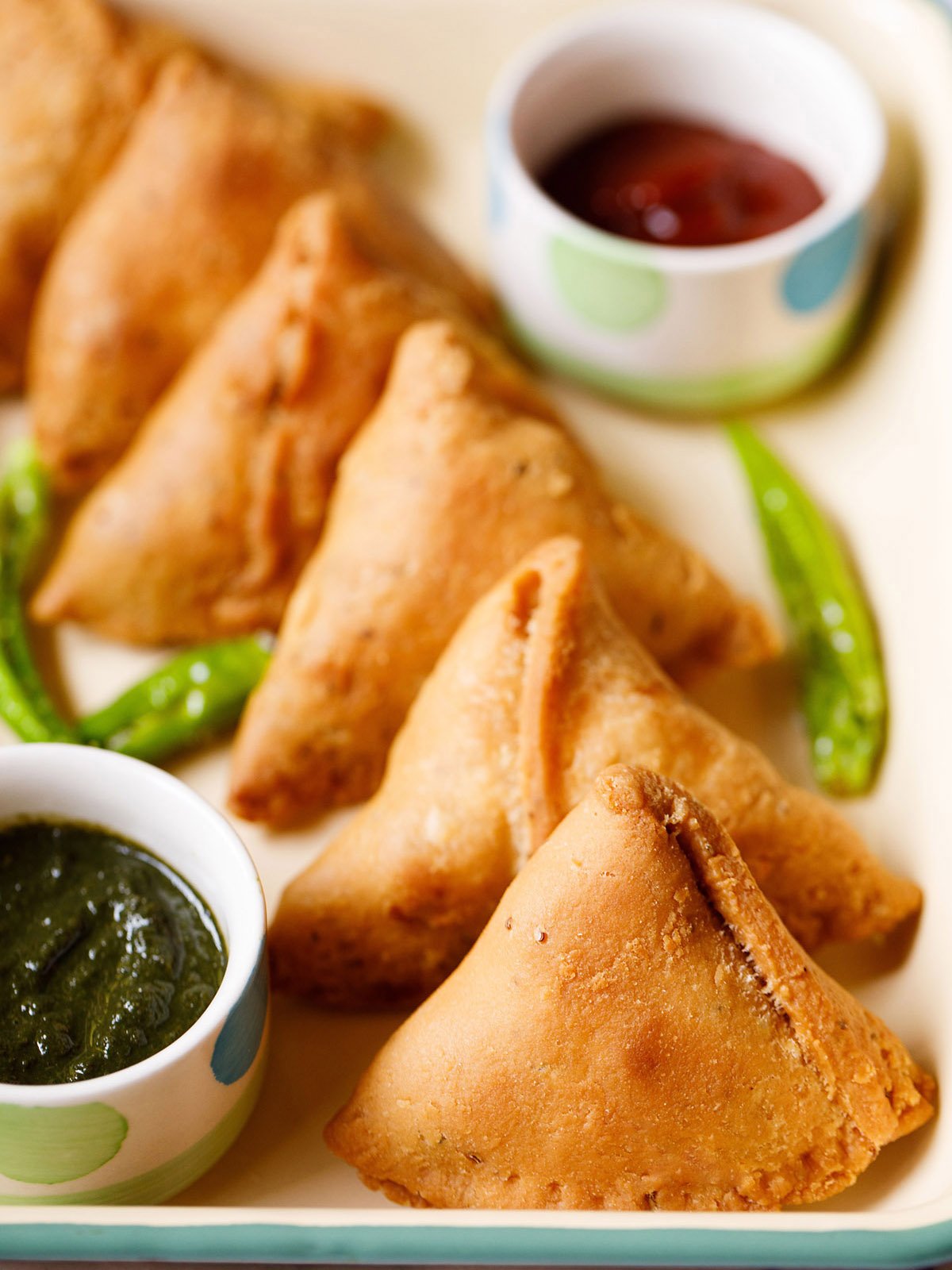
FAQs
Add 1 teaspoon lemon juice, or 2 teaspoons dried pomegranate powder for a tangy kick.
Yes! Shape and freeze them raw, or lightly fry until the crust turns opaque, then freeze. Bring to room temperature before final frying.
A few air pockets are normal, but the outer crust shouldn’t be covered with too many. This usually happens if the dough is too soft or the oil is too hot. Make sure the dough is firm and fry the samosas on low to medium-low heat.
Yes!
– Puff pastry: bake or air-fry
– Spring roll wrappers: bake or fry
– Phyllo dough: bake only
Soft dough or frying in oil that’s too cool can make samosas soggy. Always use a tight, firm dough and fry on low to medium heat.
Samosas stay fine for a few hours at room temperature. For longer storage (1 to 2 days), keep them in an airtight container in the fridge and reheat before serving.
Yes, see the air fryer instructions above.
Yes! Preheat the oven to 180°C (356°F) and bake for 30 to 35 minutes until the crust is crisp and golden. For more details and step-by-step photos, you can also check out my recipe of Baked Samosa made with whole wheat flour.
Need More Help? Common Queries Covered
Can I use whole wheat flour?
Yes, but the crust will be denser and less flaky. Add more water when kneading.
How to make fried green chilies served with samosas?
Slit whole green chilies, shallow fry till blistered. Sprinkle salt or chaat masala.
Alternate method: stuff with dry mango powder and salt, then shallow fry.
How to make this recipe vegan?
Simply use neutral oil instead of ghee in the dough.
Can I add onions in the stuffing?
Traditional Punjabi samosas don’t use onions or garlic, but you can add them. Just note that they change the flavor and moisture content.
What to do with leftover samosa?
Reheat on a skillet/tawa or in an oven. Or make a delicious Samosa Pav with spicy and sweet chutneys.
More Popular Indian Snacks
Indian Street Food Recipes
Snacks Recipes
Indian Street Food Recipes
Snacks Recipes
If you’ve tried this recipe, please rate it in the recipe card or leave a comment below – I’d love to hear your feedback. For more vegetarian inspiration, sign up for my email updates or follow me on Instagram, Youtube, Facebook, Pinterest or X.
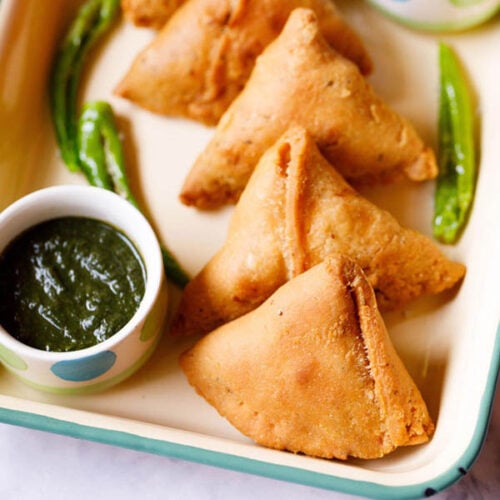
Samosa Recipe (Crispy Aloo Samosa)
Ingredients
For making samosa pastry
- 2 cups (250 grams) all-purpose flour (maida)
- 1 teaspoon carom seeds
- 1 teaspoon salt or add as required
- 6 tablespoons (50 grams) Ghee (clarified butter)
- 7 to 8 tablespoons water or add as required
For cooking potato & peas
- 3 medium potatoes (300 to 350 grams) potatoes or 3 cups chopped boiled potatoes
- ½ cup (180 grams) green peas – fresh, can use frozen peas
- 2 cups water – for steaming
Other ingredients
- 1 tablespoon oil – I used mustard oil. sunflower, canola, grapeseed oil can be used
- ½ teaspoon cumin seeds
- 1 teaspoon ginger – finely chopped, or 1 inch peeled ginger
- 2 teaspoons green chillies – finely chopped or 2 tsp finely chopped serrano peppers or 1 to 2 green chillies
- ½ teaspoon Red Chili Powder or cayenne pepper
- 1 pinch asafoetida (hing) – optional
- 1 to 2 teaspoons dry mango powder (amchur), adjust to taste
- salt as required
- 1 to 2 tablespoons coriander leaves (cilantro), chopped
- oil for deep frying – as required, any neutral flavored oil
Whole spices to be ground
- ½ inch cinnamon
- 1 clove – optional
- 3 black peppercorns
- 1 green cardamom
- ½ teaspoon cumin seeds
- ½ teaspoon fennel seeds
- 2 teaspoons coriander seeds
Instructions
Making samosa pastry dough
- Take the flour, carom seeds, salt in a bowl. Mix well and add ghee.
- With your fingertips rub the ghee or oil in the flour to get a breadcrumb like consistency.
- The whole mixture should clump together when joined and not fall apart.
- Add water in parts and knead to a firm dough.
- If the dough looks dry or floury, then add 1 to 2 tablespoons more water and knead.
- Cover the dough with a moistened napkin and set aside for 30 minutes.
Making potato and green peas stuffing
- Steam or boil the potatoes and peas till are cooked completely. Drain them of any extra water in a colander or sieve.
- Peel the boiled potatoes and chop them into small cubes
- Dry roast all the whole spices mentioned in the above list until fragrant taking care not to burn them.
- When the spices are warm or cool at room temperature, grind them in a dry grinder or coffee grinder to a semi-fine or fine powder.
- Heat oil in a pan. add the cumin seeds and crackle them.
- Add the ginger and green chillies. Sauté for a few seconds until the raw aroma of ginger goes away.
- Add the steamed green peas, red chili powder, the freshly ground spice powder, dry mango powder and asafoetida.
- Stir and sauté on a low heat for 1 to 2 minutes.
- Add the potato cubes. Mix very well and sauté for about 2 to 3 minutes on low heat with frequent stirring.
- Set aside the potato filling aside to cool at room temperature.
Assembling & shaping samosa
- After resting the dough for 30 minutes, divide the dough in 6 equal pieces.
- Take each piece and roll in your palms first to make a smooth ball.
- Then roll it with a rolling pin keeping the thickness to 1 mm throughout.
- Cut with a knife or a pastry cutter through the center of the rolled samosa pastry.
- With a brush or with your finger tips, spread some water all over the edges.
- Join the two straight ends forming a cone shape.
- Press the edges so that they get sealed well.
- Stuff the prepared samosa cone with the prepared potato-peas stuffing.
- Pinch a part on the edge (check the video & photos). This helps the samosa to stand once it is shaped.
- Press both the edges. Be sure there are no cracks.
- Prepare all the samosa this way and keep covered with a moist kitchen napkin.
Frying Samosa
- Now heat oil for deep frying in a kadai or pan. Once the oil becomes hot (test by adding a small piece of dough – it should come up quickly once added to the hot oil). Gently slide the prepared stuffed samosa & quickly reduce the flame to low.
- Turn over in between and fry until golden. Drain the fried samosa on paper towels to remove excess oil.
- Fry them in batches. For frying the second batch, again increase the temperature of the oil to medium-heat. Do not overcrowd the pan while frying.
- Add the samosa and then lower the heat, thereby decreasing the temperature of oil.
- This way fry all the samosa in batches.
Serving suggestions
- Serve samosa hot or warm with coriander chutney, tamarind chutney or tomato ketchup.
- They can also be served with a yogurt dip or plain raita. Another way is to serve it with chana masala (chickpea curry).
- We usually pair samosa with masala chai or ginger chai.
- Even bread or pav (Indian bread rolls) can be served with it.
- Whatever you serve this snack with, remember to have hot masala chai with it.
Video
Notes
- Roasting whole spices: If you are short of time to roast and grind the whole spices, then in a small bowl, simply mix 2 teaspoons ground coriander (coriander powder), ½ teaspoon ground cumin (cumin powder), ½ teaspoon ground fennel (fennel powder) and ½ teaspoon garam masala powder. Add this prepared spice mix at the step when the green peas and remaining ground spices are added while making the stuffing mixture.
- Dry mango powder: Replace mango powder with 1 teaspoon lemon juice or 2 teaspoons dry pomegranate powder.
- Green peas: Simply skip if you do not have these.
- Asafoetida: Skip it completely if you cannot find asafoetida in your city.
- All-purpose flour: You can use pastry flour and even whole wheat flour. You may need to add more water when using whole wheat flour.
- Ghee: Replace ghee with a neutral tasting oil.
- Use the amount of fat as specified in the recipe to get a flaky crust.
- Add water just enough to help you form the dough. Do not make the dough soft like a bread or roti dough. The dough should be firm and tight.
- A soft samosa dough will make air pockets happen on the crust. Too much moisture in the dough makes the crust soft as well as gives it plenty of air pockets.
- Fry samosa on a low to medium-low heat. The oil should not be medium-hot or at a high temperature as this will result in having air-pockets on the crust and will leave the crust undercooked from inside.
- The oil for deep frying can be a neutral flavored oil like sunflower, safflower, canola oil or any good vegetable oil.
- You can shape samosa and freeze them or you can fry them until the crust becomes opaque and then freeze.
- The fried samosa can be kept at room temperature for some hours. If you are not able to finish them all, then store them in an air-tight container in the fridge for a couple of days. When serving you can warm them on a skillet or in an oven until warm (at 170 degrees celsius in a preheated oven).
- Air-frying: Preheat air fryer at 180 °Celsius for 10 minutes. Brush samosa with oil and air fry at 180° Celsius till the crust is golden.
- Baking: Bake samosa in a preheated oven at 180° C/356° F for 30 to 35 minutes or until the crust becomes crisp and golden.
Nutrition Info (Approximate Values)
Samosa recipe from the archives was first published on November 2013.
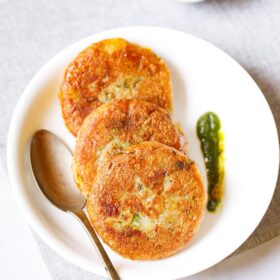
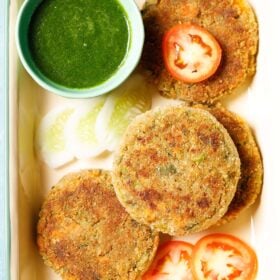
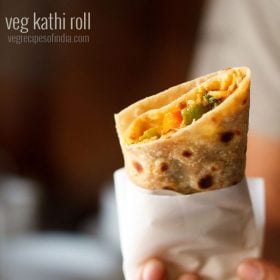
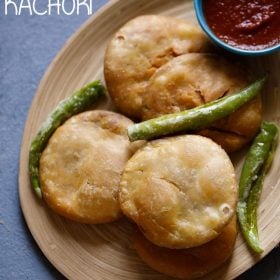
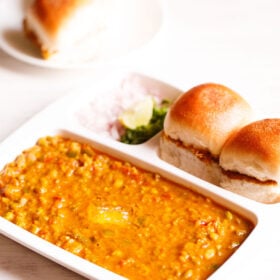
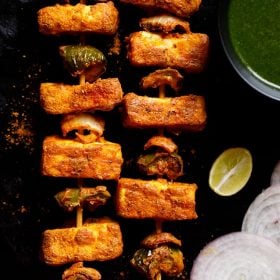
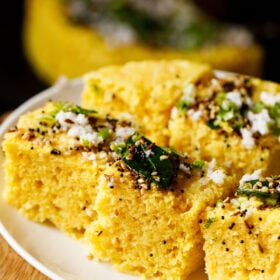
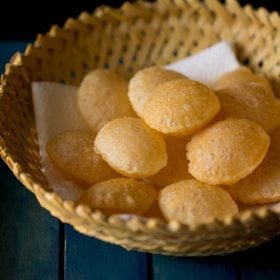








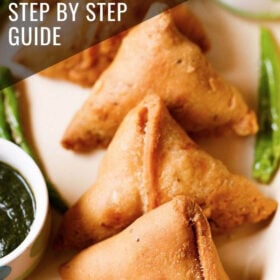
This samosa recipe is seriously better than a takeout one. Love it!
Thank you so much. Really happy to hear you enjoyed it and means a lot that you liked it even more than takeout.
Hi. First of all, thank you for all your wonderful recipes. I live in a small village in the middle of the mountains in Mexico, and it is impossible to find anything from India.
Your recipes have become famous amongst my friends here. I have made these samosas and they are all coming to sample them in a few hours. I am sure they will be a success.
Thank you again for your wonderful descriptions, photos and videos. I love Indian cuisine and your recipes always warm my heart, and my tummy 🙂
Thank you so much. I am so glad to read your feedback on the samosa as well as on the other recipes. Thanks again.
Excellent recipe. I have two questions –
Why samosas are always called as Punjabi samosas? especially in restaurants and in stores. Are there any other types or varieties of samosas? If so, what are the differences?
Instead of using all purpose flour, can I use pastry flour? This is available separately here in USA.
Thanks for your help,
There are many types of samosa variations. The Punjabi samosa has a tangy stuffing made with potatoes and green peas. The tangy flavor comes from using dry mango powder or dry pomegranate powder which are often used in Punjabi dishes.
You could try with pastry flour. It should work to give you a crispy and flaky texture.
Top recipe and flavour! I started making this for home and then offered them at a local craft market – and quickly sold out!
The only ingredient I can’t source is the ajwain but I have stuck faithfully to the rest of the ingredients.
Highly recommended for spice fiends every where as you can up the heat with extra chilli without losing the flavour. The amchur is a killer!
Greeting from the Fairest Cape, South Africa.
Thanks so much for this lovely feedback and review on the recipe. Glad!
delicious!
Wow ! Not so difficult by the way. Thanks for easy recipe. Love it.
Loved this samosa recipe from all the other various recipes that I have made from the internet. The texture of the samosa crust, the flavors, tang and taste of the potato stuffing is spot on.
Had made for a party. The samosas were so good, that even my relatives started to ask about the samosas.
They thought I had brought them from a shop. They could not believe these were homemade. Loved by everyone at the party.
I even baked a few for the health nerds in our family and they too loved it. Will make again. Thanks for sharing such an authentic and true recipe.
Thanks so much for this awesome feedback. Happy to know. Most welcome. Thanks for the rating too.
This recipe never fails! Thank you for the detailed photos and explanation. We love having samosas at our place for family gatherings and everybody loves them!
Great and thanks for sharing.
By following your step by step recipe it’s not difficult at all to make
Thank you!!
Came out perfect and tastes delicious!
Thanks a lot for this feedback and the rating as well. Most welcome.
As always good recipe and great explanation! The only problem is that these samosas disappear too fast…
Agree! And thank you.
Hi, I’ve tried a few different samosa recipe, yours is my favorite by far! However, my feet gets really tired from prolonged standing so I tried baking. I wasn’t pleased with the results.
Then I decided to fry it out if curiosity. It came out perfectly with only a few minutes of frying . So in addition to frying slowly or frying twice, Bake and Fry works too! My feet are happy !
Yes, baked samosa has a different texture as compared with a fried samosa. Thanks for sharing this method of baking and frying. Agree, it will take less time to fry. Thanks also for the lovely review on the recipe.
Your recipes are very good they are very helpful if we ever have any celebration we can quickly prepare delicious snacks easily
Thanks a lot and glad to read your feedback.
This is the first page which I look for whenever I want to try a new recipe… And it has never failed me…be it eggless chocolate cake for my kid’s birthday or a simple chutney for the humble idli. Looking to make stuffed rosette breads using samosa filling. This looks simple and tasty! Thanks for all your efforts!
Sheetal
Thanks a lot Sheetal. Glad to read your lovely comment and feedback. This filling tastes very good. I am sure it will taste good in stuffed rosette bread. Most welcome.
I’ve been following your recipes for a long time now. The way you explain, no one does. So intricate and the tiny little tips are wonderful. Thank you, for being there😍
Thanks a lot Swati and glad to read your feedback. Most welcome and Happy Cooking.